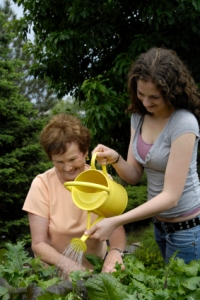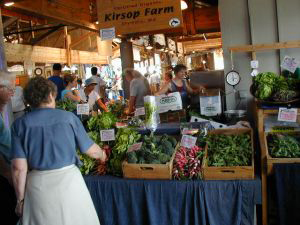 Years ago, people went to one market or general store to pick up all of the groceries and household items on their shopping list. Today, we have a variety of choices when it comes to purchasing food and beverages, from super stores and warehouse clubs to farmers markets and joining a CSA in your community.
Years ago, people went to one market or general store to pick up all of the groceries and household items on their shopping list. Today, we have a variety of choices when it comes to purchasing food and beverages, from super stores and warehouse clubs to farmers markets and joining a CSA in your community.
CSAs and farmers markets are similar in that both offer local, homegrown produce to customers at prices that are often much cheaper than at the grocery store, however they can differ in price, convenience and quality depending on where your food was grown. Regardless of whether you shop at a market or join a CSA, you are receiving fresher, higher-quality produce because it hasn’t been treated with the chemicals or preservatives necessary to mass-distribute and ship it around the world.
What is a CSA?
CSA, or community-supported agriculture, is a program that lets you purchase “shares” from a farm in exchange for a weekly delivery of fruits, vegetables and other farm products like milk, eggs and dairy.
A major benefit to joining a CSA is that you receive a wide variety of food, often items that you would not typically purchase for yourself. This often forces you to try foods you normally wouldn’t have bought in the store, and cook new, healthy recipes.
“If you’re deciding between shopping at a farmers market and joining a CSA, I don’t feel either one is better than the other,” said Janelle Vane, co-owner of Wilson’s Farm Market in Bel Air, MD. “Everyone joins a CSA for different reasons. Some people like knowing their produce is paid for, so it must be picked up and then you have it to use for the week. My members tell me that by having all this fruit and produce in their home, they feel compelled to use it, eat out less and stay home to cook.”
However, this diversity does have a downside. “You might get several weeks of vegetables you don’t like, such as beets or Brussels sprouts,” said Andrew Schrage, editor at Money Crashers, a site dedicated to helping people achieve their personal finance goals. “You might need to be a little creative in your cooking to make a CSA worth the investment.”
What is a Farmers Market?
A farmers market is a collection of individual vendors, typically farmers from the community, who set up booths, tables or stands to purvey their homegrown fruits, vegetables, dairy products and meats – among other items, that shoppers can buy directly.
“One of the biggest benefits to farmers market over CSAs is that you have complete freedom over the fruits and veggies you select. You can purchase smaller quantities, and choose the quality you require,” said Schrage. “With a CSA, you don’t typically have the opportunity to express your preferences.”
Another benefit is that going to the farmers market is enjoyable for many people. It’s an opportunity to learn about farming and experience different types of produce. Some farmers markets offer live music, chef demonstrations or entertainment and encourage people to come and mingle with their neighbors while supporting the local economy. “People who enjoy the farmers market experience need to be mindful that transitioning to a CSA means you’d have no real need to go to the farmers market,” said Schrage.
Shopping at a farmers market and joining a CSA are both cost-efficient shopping options when compared to buying fresh fruits and vegetables at your local grocery store. However, because shopping at a farmers market can sometimes tempt you to stray from your shopping list, a CSA can be more economical than a farmers market.
“The cost of visiting the farmers market each week versus joining a CSA is going to vary widely,” said Schrage. “Everything depends on where you live, how big your family is, and how much you cook.”
If you’re living alone or have a small family, you might find it difficult to use up all the food you get from a CSA. If food goes bad before you can eat it, then this is money you’ve wasted. However, many CSAs offer half-shares for smaller families and individuals to help ensure that food doesn’t go to waste.
While the average CSAs costs between $250-$500 per 16-20 week season, every CSA has different offerings. You’ll get a range of fresh vegetables, herbs, and fruits, while some CSAs have additional perks, like fresh eggs, homemade honey, fresh cut flowers, carving pumpkins or fresh meat.
“If you join a CSA that costs $400 for a season that lasts 20 weeks, this comes out to $20 per week,” said Schrage. “You’re likely spending that much, if not more, at the farmers market or supermarket each week on fresh produce, so it comes out to a pretty good deal.”
Location
No matter where you live, chances are you live fairly close to a CSA program or farmers market . The best way to find the closest markets or CSAs in your area is to head over to Local Harvest. Local Harvest is a non-profit organization that has an incredible database of CSAs, farmers markets and even farms that allow you to come buy vegetables or pick your own fruits.
The downside to joining a CSA is that there is typically one pick up location and time per week. If you have an erratic schedule, you might find yourself unable to make it to the pick-up location, thereby occasionally wasting food for which you’ve already paid.
Also Read:

